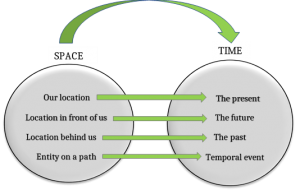Humans have the outstanding ability to use language to communicate thoughts and ideas. We can talk about physical items, describe our surroundings, or give directions. We can even communicate about much more complex and abstract ideas such as love or justice. One of the most puzzling concepts we may find hard to describe, however, is time: we do not really understand what it is nor how it happens, even though we all experience time and talk about it. We are constantly referring to the time when something happened or how long something takes or lasts; we only need a few words to time-travel to the distant past or to imagine the future that lies ahead of us. Nevertheless, how can we communicate about such a complicated concept with such a little effort? What is the role that language plays when we speak and try to understand the concept of time? This is the core question that some cognitive scientists are trying to answer, and one of the aims of my research.

Figure 1. Graphical representation of the metaphor time is space. We use our knowledge about how objects are displayed in the space to locate new temporal events. For instance, space in front of us corresponds to future events, while space behind us corresponds to past events.
You may have heard before about metaphors, perhaps from literature or poetry lectures. Metaphors are often referred to as figures of speech that establish a comparison between two things that have something in common [1], as when you say that life is a roller-coaster with its ups and downs. But metaphors are not just a fancy way of making a comparison; they play a very important role in the way we process abstract concepts. This phenomenon is addressed by the Conceptual Metaphor Theory [2]. This theory suggests that metaphors are a key cognitive phenomenon essential for human reasoning, which affects how we speak and how we understand abstract concepts. Therefore, metaphors can help us to better understand and communicate about complex concepts such as time.
So how do conceptual metaphors, and more specifically time metaphors, work? In conceptual metaphors, we use our knowledge about an idea, which is referred to as the source domain, to talk about a concept we do not know so well, what we call the target domain [2,3]. Source domains often involve more specific ideas we are already familiar with, such as moving through space, body temperature, or the weight of items. In contrast, target domains often involve more abstract and complicated ideas like emotions or events. In the case of time and temporal thinking, we often use our knowledge about space and movement through space as a source domain to talk about the more abstract and complicated concept of time, the target domain (see Figure 1).
In case of English language, and continuing with the time-is-space metaphor, speakers can say that future events are in front (e.g., look forward to the future) and past events behind (e.g., back in those days). They can even move through time (e.g. we are approaching the holiday season), make temporal events move towards them (as Jon Snow would say, Winter is coming), or they can talk about the duration of those events (e.g., a short day or a long meeting). All of it using only spatial language!
But what happens when we look at other languages? It turns up that different languages talk and understand time differently. For instance, speakers of Aymara, an aboriginal community in South America, place future events behind them, while past events are in front of them [4]. Mandarin Chinese speakers place earlier events “up” and later events “down” [5], while speakers of Kuuk Thaayorre, a Paman language spoken in the Pormpuraaw community, in Cape York; use terms equivalent to cardinal directions to talk about time [6].
All this evidence made me wonder if I, as a Spanish and English speaker, could also talk about and understand time in two different ways. Thanks to the SRUK/CERU On the Move program, I conducted a research project at University of Murcia together with Professor Javier Valenzuela to investigate the differences between English and Spanish temporal language. After analysing large quantities of linguistic data (known as corpus analysis), as well as comparing parallel translation of both languages, we established that indeed, there are two fundamental differences in the way English and Spanish speakers talk about time [7].
The first difference is caused by how these two languages are structured. English is a satellite-framed language, that is, verbs are often accompanied by small particles or prepositions that indicate things like motion or direction (e.g., go up, sit down, put aside). On the other hand, Spanish is a verb-framed language, in which those small particles are implicit in the verb (e.g., subir, sentarse, apartar; which correspond to the verbs in the example above, respectively). These differences make English temporal expressions to often signal the direction of time (e.g. back in those days, months ahead of), while, Spanish speakers may omit this directional information (e.g., entonces, meses antes, en ese momento).
The second difference about how these languages talk about time has to do with how they measure duration. Spanish speakers are more used to quantifying time using expressions such as mucho tiempo (i.e., mucho meaning “a lot”), using a time-is-quantity metaphor in which events are units that can be counted or divided. On the other hand, English speakers are more likely to think of time in terms of length, measuring the distance between two points in time (e.g., how long does it take?) through the time-is-space metaphor [7]. Both strategies for understanding time are possible in both languages (largo tiempo and much time), but the frequency of its use and amount of exposure favour a duration-as-quantity metaphor in Spanish and a duration-as-length metaphor in English [8,9,10].
Speaking different languages can lead you to talk and, potentially, think differently about the concept of time. The latest research on language and cognitive science suggests that language has a big influence on the way we think about a wide range of concepts, including time, numbers, or colours (check this incredible Ted Talk by Lera Boroditsky). Language is not only a useful tool we use every day to communicate, but a key element that shapes how we see and understand the world.
* * *
By Daniel Alcaraz Carrión, postdoctoral researcher at University of Murcia who was awarded with the SRUK/CERU On the Move scholarship to carry out a Postdoctoral Fellow at CREATIME. You can visit Daniel’s website here.
More information:
- Metaphor, as described in the Cambridge Dictionary.
- Lakoff, G. & Johson, M. (1980).
- Post “Source Domain in Conceptual Metaphor”, source ThoughtCo.
- Núñez, R. & Sweetser, E. (2006).
- Boroditsky, L. (2001).
- Boroditsky, L. & Gaby, L. (2010).
- Valenzuela, J. and Alcaraz Carrión, D. (2020).
- Casasanto, D. (2010).
- Bylund, E., & Athanasopoulos, P. (2017) .
- Dolscheid, S., Shayan, S., Majid, A., & Casasanto, D. (2013).



